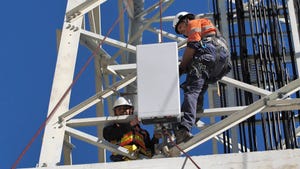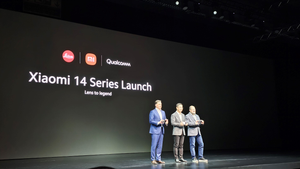How Skylo is quietly succeeding in the phone-to-satellite race
Skylo is a relatively small startup in the direct to device (D2D) market. But it recently captured millions in new funding and an important new agreement with smartphone chipmaker Qualcomm.

Startup Skylo, founded in 2017 by a team from Stanford University's space lab, recently raised $37 million in funding from the likes of Intel Capital and Innovation Endeavors. That announcement came shortly after the apparent collapse of Skylo's first big customer, rugged smartphone maker Bullitt. But it also preceded chip giant Qualcomm's announcement that its new Snapdragon X80 5G modem would support satellite connections through Skylo's system.
Tarun Gupta, co-founder and chief product officer at Skylo, told Light Reading recently that the company's progress in the phone-to-satellite market is due to some prescient technology bets the company made in its early years. Specifically, Gupta said Skylo's founders settled on using NB-IoT transmission technology before it was officially incorporated into the 3GPP's Release 17 batch of specifications for phone-to-satellite communications.
Meaning the company's Network Operations Center (NOC), NB-IoT radio access network (RAN), satellite connections, chipset certifications and customer support systems have all already been deployed around that technology. Indeed, Gupta said the company's systems have already handled more than 1 million satellite-based messages.
"It takes an ecosystem to make this work," Gupta explained.
And in the case of Skylo, that ecosystem is ready to go today. Other such offerings – such as T-Mobile's direct-to-cell deal with SpaceX – remain in testing.
How it works
As noted by SpaceNews, Skylo emerged from stealth in 2020 with $116 million in funding. Gupta said the company initially planned to target the IoT market with satellite connections, but quickly pivoted to the direct to device (D2D) space amid Apple's release in 2022 of the iPhone 14. The gadget supports emergency messaging services through Globalstar's satellites and kicked off a race among chipmakers, satellite operators, mobile network operators and others to offer similar capabilities.
But how is Skylo – a company that doesn't own spectrum or satellites – able to compete in an industry where both are required? Gupta said Skylo works with satellite operators like Viasat, Ligado Networks and TerreStar with "bent pipe" satellite networks. Such satellites essentially bounce signals originating on Earth back down to company ground stations – meaning, they can handle all kinds of transmission technologies, including NB-IoT, because they're basically just big mirrors in space. "What you put in is what you get out," Gupta explained. He added that Skylo opted to work with NB-IoT signals because they're able to reach satellites and then be reflected back down to Earth, unlike some other transmission technologies.
Skylo's setup, Gupta said, allows NB-IoT devices to broadcast their signal to one of the eight geostationary satellites in Skylo's network (Viasat, Ligado Networks and TerreStar operate those eight satellites). Then the signal is reflected back down to one of those satellite companies' ground stations – where Skylo operates its own NB-IoT RAN network to receive such signals and process them through Skylo's core network. The result is that Skylo is essentially able to "capture" NB-IoT signals that are out of range of terrestrial cell towers, and then transmit those signals back to terrestrial mobile network operators via a connection to those operators' core networks. Skylo basically works like a mobile network operator's international roaming partner, sending out-of-reach messages back into that operator's core.
More recently, Skylo has managed to obtain another key piece to its puzzle: devices. The company noted that – thanks to Qualcomm's new Snapdragon X80 5G modem and other similar chips – new smartphones won't need a separate NB-IoT chip to connect to the satellites operated by Skylo's partners. Instead, Qualcomm smartphone customers like Samsung will be able to purchase the chip vendor's X80 5G modem and begin offering iPhone-style emergency satellite messaging without any further technological steps.
A market in upheaval
Bullitt, the rugged smartphone maker, was Skylo's first big public customer. It released a phone capable of satellite-based messaging by using a separate NB-IoT chip from MediaTek. However, Bullitt has since shuttered operations and company officials are not responding to questions from the media.
Never mind that, according to Gupta. The company now has an agreement with Qualcomm, one of the world's biggest providers of chips for smartphones. Indeed, Qualcomm's embrace of Skylo comes just a few months after Qualcomm backed out of a phone-to-satellite deal with satellite vendor Iridium. Importantly, Iridium does not offer a "bent pipe" satellite network, but instead links its satellites together.
Skylo's system is also different from those offered by AST SpaceMobile, Lynk Global and SpaceX. That's because Skylo's system does not rely on spectrum owned by mobile network operators. Instead, its messages run through satellite spectrum owned by the likes of Viasat, Ligado and TerreStar.
Thus, Gupta explained, Skylo's system is more of an overlay atop terrestrial mobile networks, plugging coverage holes not only in rural areas but also in urban areas. Because it works on different spectrum, it won't suffer from the D2D interference concerns that continue to dog T-Mobile (via satellite partner SpaceX) and AT&T (via satellite partner AST SpaceMobile.
"We provide that overlay," Gupta explained.
Indeed, it appears Skylo's approach is more in line with Verizon's strategy for D2D connections. "We think the best use of our spectrum is our terrestrial network," Verizon's networking chief, Joe Russo, told FierceWireless. He said Verizon continues to watch the D2D market but has no specific satellite messaging partner like AT&T and T-Mobile do.
To be clear though, Skylo isn't alone. A wide range of other companies – from Iridium to Omnispace to Midwave Wireless – are also pursuing the market for Supplemental Coverage from Space (SCS). How the market plays out – as well as overall consumer demand for satellite connections – remains to be seen.
Gupta declined to discuss Skylo's finances, as well as its customers beyond Bullitt.
About the Author(s)
You May Also Like












